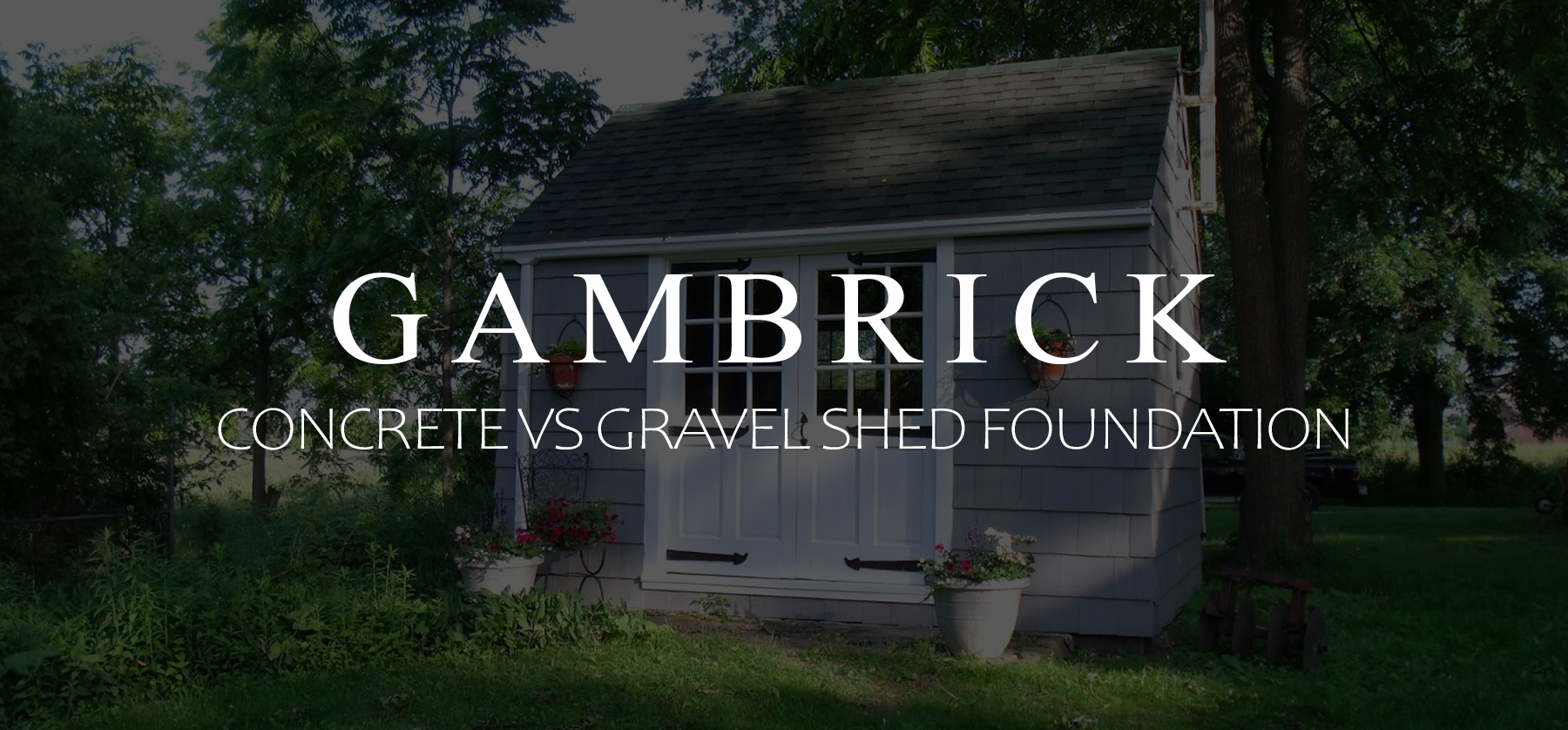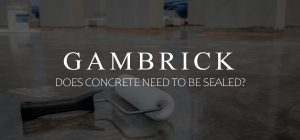
Concrete Vs Gravel Shed Foundation
Concrete vs gravel shed foundation. Which is best? Which one is cheaper? What’s stronger? Are there major differences? These are all great questions that you’ll need answers to if your planning on building a new shed. I’ve been a builder for over 25 years and can tell you firsthand that both shed foundations have their pros and cons, so there’s no clear best. Gravel shed foundations are easier and cheaper to install. They provide better drainage and allow you to move the shed any time. But they don’t provide much strength. On the other hand concrete is a permanent shed foundation which is very strong. You can have footings and anchor bolts just like a house. But they’re more expensive and can’t be moved.
Concrete floors are great for bolting down machinery but stain easily. Gravel is easier to keep clean and can be changed at any time, but doesn’t provide much strength.
One question you need to answer is do you need a foundation for your shed. If you do, then the next question to answer is what’s the best shed foundation for your situation and how thick should the concrete be?
If you live in a hurricane prone area, I’d recommend going with at least 4 inch thick concrete, with footings and anchor bolts. But if you need flexibility and may want to move the shed, a gravel foundation is the way to go.
Do you want to bolt down equipment or benches? Choose concrete. Will you be washing things in the shed and need more drainage? Gravel would be better.
As you can see, both foundations are great, but serve a different purpose for your shed.
Gravel Shed Foundation Pros Vs Cons
A gravel foundation is a great option for a wide variety of shed designs. If your buying a prefab shed with a wood floor then it’s probably your best bet. They’re cheap and easy to build. And the prefab shed can be built on top in a day.
Pros
- Less expensive than concrete.
- Suitable for small to medium-sized sheds.
- Quick and easy to install. Great for DIYers.
- A great choice for temporary sheds.
Cons
- Can’t support the weight of large sheds.
- If the soil is wet, the foundation may settle.
- Easier for moisture to seep into the shed through the gravel.
- Pests can get into the shed.
- If you’re building a permanent shed, local codes may require concrete.
- May erodes over time as the gravel shifts or washes away.
Drainage
A gravel shed foundation provides much better drainage than concrete.
A concrete floor can’t absorb or drain water unless you also install a floor drain.This adds cost and a lot of extra work to the foundation. Excavation would have to be done to pipe the drain to a curb or drainage area.
Gravel is better for rain water too. Heavy water will run through a gravel foundation but it has to go around concrete. This creates additional work because grading has to divert water away and around a concrete shed foundation in the same way water is diverted away from a house.
Concrete doesn’t dry out as quickly as gravel so when it does get wet it will stay that way for a while.
Water can sit on concrete which can rot wood that touches the concrete. This isn’t as big a problem with gravel because standing water quickly drains away.
Splashing
A gravel foundation diffuses water as it hits it. The rough, porous and uneven surface of the gravel prevents water and other liquids from splashing up and onto the walls. Instead of splashing, the water will quickly absorb into the ground.
With a concrete base, spilled water can splash up against the sides of the shed or interior walls. This can cause the wood at the base of your shed to rot over time.
Splashing can also lead to stains. If your like me and use a shed to do gardening work and wash pots then you’ll know how dirty the base of the walls can get from splashed water. This is greatly reduced with a gravel base. However the benefit is only there if your shed floor is gravel. If you’ve got a wood floor built on a gravel foundation then there’s no benefit.
Cost
A gravel shed foundation is much cheaper than concrete. This is true in terms of labor and materials.
If your local building code doesn’t require a concrete foundation then a gravel pad can save you a lot of money.
Options
There are more options when you go with a gravel shed foundation over concrete. Unless you stain or stamp the concrete, it’ll be grey. But there are dozens of different rocks in all sorts of shapes, colors and sizes that make a great base.
If you’re using the gravel foundation as your actual shed floor, choose a color that’s attractive and a rock that’s easy to walk on.
If your building a prefab shed with a wood floor on a gravel foundation then choose a gravel color that looks good with your siding and hardscaping.
A gravel shed foundation also gives you the option of moving the shed. Simply take the shed apart, move the gravel and rebuild the shed. This can be done with concrete too but it’s much harder and a lot more expensive.
DIY
A gravel base for an average sized backyard shed can usually be poured in a day. It makes a great DIY weekend project, especially if you have enough room to back the truck up to the site. The only hard work is excavation but you can rent a machine for that.
If your building your own gravel shed foundation then make sure to excavate at least 4-6 inches. Compact the earth before you pour rock and use some landscaping felt to prevent weeds. Also make sure to level the ground. This will make it easier to build the shed.
Strength
One of the only cons of a gravel shed foundation is strength. You won;t be able to use anchor bolts or any tie down without some concrete. You also won’t be able to bolt anything down to the foundation because it’s just loose gravel.
If you need a strong base then the only option is concrete.
Concrete Shed Foundation Pros Vs Cons
If your shed is a permanent structure that’s for more than just storing a lawnmower, you may want a sturdy foundation built out of concrete.
While a concrete base is much more expensive than gravel and harder to build, it comes with lots of benefits.
Pros
- Supports more weight without shifting or cracking.
- Can support large sheds including multi story designs.
- A permanent foundation that will last for decades when properly built.
- Suitable for sheds with or without a floor.
- May be required by local building codes for permanent structures.
- Looks great.
- Considered a higher end option.
Cons
- More expensive than gravel.
- Concrete slabs can crack from seasonal changes in temperature when not installed properly.
- If the ground shifts underneath, the concrete may crack.
- Requires more excavation if you also include footings.
- More difficult to build.
- May need a drainage to prevent flooding.
- Bad drainage unless you add a floor drain.
Regulations
Some local building codes require a concrete foundation or footings for a shed. This is especially true in areas that are prone to high winds. Check your local building codes to find out.
There are several types of concrete foundations that may meet requirements. These requirements may vary based on the type of shed your building. A small shed may only require concrete piers at each corner with a gravel floor. However, a large shed may need footings and a concrete slab floor.
I recommend getting some plans for the shed you want to install and bringing them to your local building department.
Strength
As we’ve already mentioned, a concrete shed foundation is great for larger structures that need more support. The concrete can be for more than just the floor. Footings can also be installed with anchors that tie the structure to the ground. The shed can then be grounded which makes it safer in a lightning storm.
Concrete floors are also better if you want to bolt down machinery. I keep some wood working equipment in my shed that needs to be securely anchored to the floor. Without concrete the equipment would be unusable.
A concrete base also comes in handy if your working on machinery that needs to be jacked up. Gravel doesn’t make a very sturdy flooring.
Looks
Many people love the look of concrete floors. In fact they’re gaining popularity inside many Modern style homes. They can be polished, colored, stamped, textured or left bare. It’s a very versatile material that looks great in a variety of home styles.
Concrete floors are also a much higher end look when compared to gravel. It’s a more expensive foundation that’s intended for a permanent structure. Generally we use gravel for pre-fab sheds and concrete for custom built ones.
Pests
A shed built on a concrete foundation can have a seal just as tight as a house. This makes it very hard for pests to get into the shed from under the walls. But this isn’t the case with gravel. If your building a shed right on top of a gravel foundation there’s very little to stop animals or bugs from getting in.
Stains & Drainage
Two of the cons associated with a concrete shed foundation are drainage and stains.
Concrete stains easily and is hard to clean. If your doing work inside the shed that’s messy you may prefer gravel.
Concrete doesn’t drain well. To compensate for this, floor drains can be installed. But these are expensive and require lots of excavation as well as a spot to drain into.
Cost
The high cost of concrete is another issue you’ll have to consider. If your trying to save money by installing a pre-fab shed you bought at Home Depot then go with gravel. It’ll save you a lot when compared to concrete. However, if your building a large custom shed then you’ll probably want to go with concrete.
In terms of cost,you should consider the ROI. A shed can add value to your home. You should go with the foundation option that suits the shed design you’re building.
Should A Shed Foundation Be Bigger Than The Shed?
If you’re using a concrete shed base, the concrete slab should be the same size as the shed. However,if you’re using a gravel foundation, the gravel base should be 12” wider on all sides.
A 12” lip on a gravel shed foundation has several benefits:
- Protects wood siding from puddling or splashing water which prevents rot.
- Keeps your shed cleaner as soil can’t splash onto it.
- Keeps grass and weeds away from the shed walls which makes mowing easier.
- Reduces water runoff by providing more gravel for drainage.
What Type Of Gravel Is Used For A Shed Foundation?
Concrete vs gravel shed foundation. If you choose gravel then you’ll have to choose a rock. The best choice of gravel for a shed base is ¾-inch drainage rock, a.k.a. trap rock. The right size gravel allows for enough compaction to make a firm base while also allowing water to drain.
Larger or smaller stones can also be used or you can use a combination of stones. It depends a lot on the type of soil you have and how you’ll be using the shed. For heavier loads you’ll want a stone that compacts well. However, if you need more drainage use a jagged stone that settles with more open spaces.
No matter what type of stone you use, make sure to compact the gravel.
Concrete Vs Gravel Shed Foundation. Which Is Best?
The shed foundation that’s best is very situational. Both gravel and concrete are great for foundations but they do different things. Here are a few situations to help you decide which material is best.
- If you need more drainage inside and around the shed then go with gravel. It’s much better in this regard.
- Concrete is stronger. If you plan on building a large or custom shed then go with concrete.
- Gravel sheds are great for smaller pre-fab sheds you can buy online or at Home Depot.
- If your shed has a wood floor then gravel is a great option.
- If you live in a high wind area and needs strong anchors then go with concrete or footings.
- Temporary sheds would be better with a gravel foundation.
Summary: Concrete Vs Gravel Shed Foundation
A concrete vs gravel shed foundation. Which is best? Which one is cheaper? What’s stronger? Are there major differences? These are all great questions that you’ll need answers to if your planning on building a new shed. Both shed foundations have their pros and cons so there’s no clear best. It’s very situational. Gravels shed foundations are easier and cheaper to install. They provide better drainage and allow you to move the shed any time. But they don’t provide much strength. On the other hand concrete is a permanent shed foundation which is very strong. You can have footing and anchor bolts just like a house. But they’re more expensive and can’t be moved. Concrete floors are great for bolting down machinery but stain easily. Gravel is easier to keep clean and can be changed at any time.
One question you need to answer is do you even need a foundation for shed. If you do then the next question to answer is what’s the best shed foundation for your situation and needs? If you live in a hurricane prone area then I’d recommend going with concrete, footings and anchor bolts. But if you need flexibility and may want to move the shed the gravel is the way to go. Do you want to bolt down equipment or benches? Choose concrete. Will you be washing things in the shed and need more drainage? Gravel would probably be better.
And then there’s flooring.
- Gravel is the best shed foundation for portable buildings that come with a wood floor.
- Concrete is the best shed foundation for a strong shed without a pre-built floor.
If you have any questions or comments about shed foundations Email any time.

John Mazzuca | About | More Posts |
Custom Home Builder
John Mazzuca is a custom home designer and builder at Gambrick with over 25 years experience in the construction industry. John has designed, built and/or remodeled hundreds of homes, small buildings, and commercial projects. He writes about business, real estate, home building, and household electronics. His work has been featured in Fox Business, Better Homes & Garden, House Beautiful, and more.




















